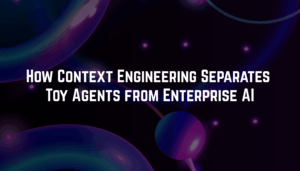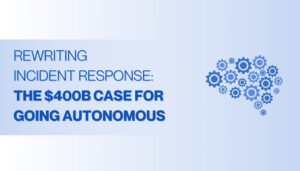The Integration Imperative: Why AI SRE Success Depends on Data Orchestration, Not Just Better Models
Part 2 of 3: The AI SRE Reality Check
Here’s an uncomfortable truth about the AI SRE market: everyone has access to essentially the same foundational models. Whether you’re using GPT-4, Claude, or Llama, the raw reasoning capabilities are becoming commoditized. The vendors pitching you their “revolutionary AI SRE solution” are often using the same LLMs you could access directly.
So if the models are commoditized, what creates real differentiation? The answer lies not in the intelligence of the AI, but in the intelligence of how you feed it information. The winners in AI SRE won’t be determined by who has the best model—they’ll be determined by who can provide the best context.
The Model Myth: Why LLM Access Doesn’t Equal SRE Success
Walk into any AI SRE demo and you’ll hear impressive claims about model capabilities. “Our AI can analyze logs at superhuman speed!” “We use the latest GPT model for unprecedented accuracy!” “Our reasoning engine processes thousands of metrics simultaneously!”
All of this might be true, but it misses the fundamental challenge of enterprise SRE: the problem isn’t processing individual data points—it’s understanding the relationships between them across disparate systems, time windows, and data formats.
Consider a typical incident in a modern enterprise environment:
- A Kubernetes pod starts crashlooping
- API response times spike in your application monitoring
- Database connection pools show increased latency in your observability platform
- CloudWatch metrics indicate resource constraints
- Your log aggregation system captures error messages across multiple services
An AI that can analyze any one of these signals brilliantly is still useless if it can’t correlate them into a coherent narrative. And here’s where most AI SRE solutions fail: they treat each data source as an isolated island rather than part of an interconnected ecosystem.
The Context Problem: Why Most AI SRE Tools Fail at Complex Investigations
The dirty secret of many AI SRE solutions is that they’re essentially sophisticated log analyzers with chatbot interfaces. They can parse individual data streams effectively, but they struggle with the kind of cross-system correlation that defines real-world incident response.
Let’s look at what happened with one of our customers—a leading AI insights company that was experiencing mysterious performance degradation. Their previous monitoring approach involved engineers manually jumping between:
- CloudWatch for AWS infrastructure metrics
- ECS configurations for container-level insights
- Application logs scattered across multiple services
- Performance monitoring dashboards showing symptoms but not causes
The engineering team was spending hours correlating these disparate data sources, trying to build a coherent picture of what was happening. By the time they identified root causes, incidents had often escalated beyond their initial scope.
When they deployed Hawkeye, the transformation was immediate. Instead of treating each telemetry source as a separate problem, Hawkeye established a unified view across their entire AWS environment. The result? A 90% reduction in mean time to resolution, with full root cause analysis delivered in under 5 minutes.
As their CEO explained: “By the time our team is paged, the root cause is already clear. We’ve reclaimed engineering time, cut down off-hours firefighting, and accelerated resolution by 10x.”
The Hybrid Advantage: Data Virtualization + MCP Integration
Most AI SRE vendors are taking a monolithic approach to data integration—trying to solve every integration challenge with a single method. At Neubird, we recognized early that different types of data and interactions require different approaches. That’s why we built a hybrid architecture that combines the best of both worlds.
Data Virtualization for Correlation Power: For time-series data, traces, configurations, and logs—the foundational telemetry that requires correlation across systems—we use sophisticated data virtualization. This creates a unified schema across all your observability tools, enabling Hawkeye to perform cross-system joins and correlations that would be impossible with traditional point-to-point integrations.
Think of it this way: instead of having Hawkeye query your Prometheus instance, then your Splunk index, and then your CloudWatch metrics as separate operations, our data virtualization layer presents all of this information as a unified, queryable dataset. This enables complex correlations like: “Show me all instances where Kubernetes resource constraints occurred within 5 minutes of database connection pool exhaustion, correlated with API gateway error rates exceeding baseline.”
MCP Integration for Real-Time Tool Access: For real-time command-line operations and specialized sub-systems, we embrace Model Context Protocol (MCP) integration. This gives Hawkeye direct access to tools like kubectl, AWS CLI, Azure CLI, Confluent CLI, and other operational interfaces that SRE teams use daily.
But we don’t stop at individual tool access. We’re pioneering the next frontier of enterprise AI operations: collaborative agent ecosystems. Through emerging protocols like Google’s Agent2Agent (A2A), we’re enabling Hawkeye to coordinate with specialized agents—DBA agents with deep database access, security agents with threat intelligence platforms, cost optimization agents with business context. This collaborative approach creates collective intelligence that no single agent could achieve alone, transforming enterprise operations from isolated AI assistance to orchestrated agent ecosystems working in concert. Make sure to read Part 3 of this series for more details on our plans for multi-agent workflows.
Why This Hybrid Approach Wins: The combination creates capabilities that neither approach could achieve alone. Data virtualization enables the complex correlations that identify problems, while MCP integration enables the real-time investigation and validation that confirms root causes.
A custom technology solutions company experienced this power firsthand when they faced a complex issue spanning their entire AWS stack—RDS, SQS, ElastiCache, and Lambda services. Instead of their engineers spending days jumping between different monitoring interfaces and CLI tools, Hawkeye correlated the telemetry data to identify the root cause, then verified it through direct system queries via MCP interfaces. Total resolution time: minutes instead of days.
The Knowledge Integration Layer: Turning SRE Expertise Into AI Context
While data virtualization and MCP integration solve the technical data access challenge, enterprise AI SRE success requires solving an equally important problem: knowledge capture and application. The most valuable insights for incident resolution often exist in the minds of experienced SREs—understanding application behavior patterns, knowing which metrics matter most for specific services, recognizing seasonal traffic variations, and remembering lessons learned from past similar incidents.
Traditional monitoring solutions treat this knowledge as external to the system. SREs have to remember these insights and manually apply them during each investigation. Hawkeye takes a different approach: it treats SRE knowledge as a first-class data source that can be captured, refined, and applied automatically.
Real-Time Knowledge Coaching: During investigations, SREs can provide contextual guidance directly within Hawkeye’s interface. Comments like “this service typically shows high CPU during batch processing hours” or “ignore Redis connection spikes during deployment windows” become part of Hawkeye’s understanding for future incidents involving these systems. This contextual coaching happens naturally as part of the investigation workflow, without requiring separate documentation processes.
Institutional Memory From Past Incidents: Every resolved incident becomes training data for future investigations. Hawkeye automatically identifies patterns between current symptoms and historical resolutions, surfacing relevant past incidents and their solutions. But more importantly, it learns to recognize when current incidents share characteristics with past ones, enabling faster root cause identification based on organizational experience rather than just generic algorithmic analysis.
Application Context Integration: Most enterprises have rich contextual knowledge about their applications—deployment patterns, dependency relationships, business impact hierarchies, and operational characteristics—but this information is scattered across wikis, runbooks, and SRE team knowledge. Hawkeye provides structured ways to capture this context and automatically applies it during investigations, ensuring that business-critical services get appropriate prioritization and that investigation approaches match application-specific characteristics.
Beyond Point Solutions: The System Integrator Revolution
While most AI SRE vendors are focused on selling directly to end customers, we’re seeing a more sophisticated trend emerge: system integrators embedding AI SRE capabilities directly into their digital service desk offerings.
This isn’t just about API access—though our API-first architecture makes these integrations seamless. It’s about recognizing that enterprises don’t want to replace their entire operational ecosystem. They want to enhance it.
Major system integrators are building Hawkeye into their managed services offerings because it allows them to deliver expert-level SRE capabilities without the overhead of hiring and training specialized talent. For their enterprise clients, this means getting AI-powered incident response that’s integrated into their existing workflows, ticketing systems, and escalation procedures.
This approach is transforming how enterprises think about operational capabilities. Instead of building internal SRE teams or hoping their existing staff can keep up with increasing complexity, they’re getting access to AI-powered expertise that’s embedded in their existing operational processes.
Universal Compatibility: Meeting Customers Where They Are
Here’s something you won’t hear from most AI SRE vendors: they’ll only tell you about the observability tools they integrate with easily. At Neubird, we’ve taken a different approach, we support more observability solutions than any other AI SRE platform because we’ve learned that enterprises use whatever combination of tools serves their needs best.
Our customers don’t live in single-vendor worlds. They use:
- Splunk for log analysis alongside Prometheus for metrics
- Grafana for visualization while DataDog handles APM
- CloudWatch for AWS services mixed with Azure Monitor for hybrid deployments
- New Relic for applications integrated with Elastic for search and analytics
Traditional integration approaches break down in these mixed environments. Each tool requires custom connectors, different authentication methods, varied data formats, and unique query languages. The result is usually a fragmented view where AI can analyze individual tools effectively but struggles to correlate insights across the entire stack.
Our data virtualization approach solves this by creating a unified interface across all these tools. From Hawkeye’s perspective, it doesn’t matter whether data is coming from Splunk or Elastic, Prometheus or DataDog—it’s all part of a coherent, queryable dataset that enables comprehensive analysis.
Hybrid and Multi-Cloud Reality: Agents That Work Where Problems Actually Live
While the industry talks about the future of cloud-native operations, enterprises are dealing with the reality of hybrid environments today. Many organizations are managing on-premises data centers with strict governance requirements, disaggregated Kubernetes clusters running across multiple environments, data silos that can’t easily be exposed to external services, and security policies that prevent broad telemetry sharing with third-party platforms.
This is where Neubird’s approach to agentic workflows differentiates from cloud-only solutions. Hawkeye isn’t confined to a single cloud provider or tied to a narrow slice of infrastructure. It’s designed to operate across the complex, heterogeneous environments where real-world problems actually live.
Deployment Where You Need It: Our customers have deployed Hawkeye inside private data centers, within highly restricted VPCs, and across multiple cloud providers simultaneously. This deployment flexibility enables Hawkeye to access telemetry and perform investigations regardless of where your infrastructure lives, without requiring you to expose sensitive data to external platforms or standardize on a single cloud provider’s ecosystem.
Governance-Aware Operations: Real enterprise environments have compliance requirements, data residency constraints, and security policies that affect how AI agents can operate. Hawkeye’s architecture accommodates these requirements by design, enabling intelligent operations while respecting organizational boundaries and governance frameworks.
This real-world deployment experience has taught us that the future of agentic workflows isn’t just about building smarter agents—it’s about building agents that can actually be deployed and trusted in the complex environments where enterprises operate today.
Real Impact: When Superior Integration Meets Real Problems
The proof of superior integration architecture isn’t in the technical specifications—it’s in the results customers achieve when facing their most complex operational challenges.
Consider what happened with a large infrastructure and software provider using Splunk on AWS. Their engineers were spending hours manually analyzing logs and incident data, leading to prolonged troubleshooting cycles. The complexity of their IT environment required specialized knowledge across multiple domains, making root cause analysis increasingly difficult.
After implementing Hawkeye, issues that previously required hours of log analysis were diagnosed and resolved in minutes. But the key wasn’t just faster log analysis—it was Hawkeye’s ability to automatically correlate data across their entire Splunk deployment, identifying patterns and relationships that would have taken human analysts much longer to discover.
As they noted in their lessons learned: “Cross-system correlation accelerates diagnosis. Our complex environment revealed that the most challenging incidents often involve interactions between multiple systems. Hawkeye’s ability to correlate data across our entire infrastructure was crucial in reducing time to root cause analysis.”
The Correlation Capability Gap
This brings us to the fundamental difference between AI SRE solutions that work in demos and those that excel in production: correlation capability. Most solutions can tell you what’s happening in individual systems. Few can tell you why it’s happening across multiple systems.
Real incidents rarely respect the boundaries of monitoring tools. A performance problem might start with a configuration change captured in your ITSM system, manifest as resource constraints in your infrastructure monitoring, appear as error rates in your APM solution, and impact customer experience metrics in your business intelligence platform.
Solutions built on traditional integration approaches—whether that’s individual APIs, webhook notifications, or even lists of MCP servers—struggle with this correlation challenge. They can access each system individually, but they can’t easily perform the complex joins and temporal correlations that turn individual signals into actionable insights.
Our data virtualization approach treats all telemetry sources as part of a unified dataset, making these correlations not just possible, but natural. Instead of asking Hawkeye to query five different systems and manually correlate the results, we can ask it to find patterns across all systems simultaneously.
Why This Matters for Your Enterprise
If you’re evaluating AI SRE solutions, don’t be distracted by model capabilities that everyone has access to. Focus on integration architecture that determines what context the AI actually receives.
Ask potential vendors:
- How do you handle correlation across different observability tools?
- Can you perform temporal joins across disparate data sources?
- How do you manage authentication and authorization across multiple systems?
- What happens when we need to correlate real-time CLI output with historical telemetry data?
- How do you handle schema drift and API changes across our tool ecosystem?
The vendors that give you detailed, architecture-focused answers are the ones building for enterprise reality. The ones that pivot back to model capabilities are the ones that haven’t solved the hard problems yet.
The Future of AI SRE Integration
As we look ahead, the integration challenge is only going to become more complex. Enterprises are adopting more observability tools, not fewer. Multi-cloud deployments are becoming standard. The number of specialized monitoring solutions continues to grow.
The AI SRE solutions that succeed will be those that can adapt to this increasing complexity without requiring enterprises to standardize their entire observability stack around a single vendor’s ecosystem.
At Neubird, we’re not just building for today’s integration challenges—we’re building for tomorrow’s collaborative agent ecosystems. Our roadmap includes expanded MCP server support for emerging operational tools, enhanced data virtualization capabilities for next-generation observability platforms, and pioneering implementation of Google’s Agent2Agent (A2A) protocol for seamless inter-agent communication. We’re enabling Hawkeye to serve as the coordination hub for enterprise agent ecosystems, where specialized agents collaborate on complex operational challenges—each bringing their own expertise and data access to create collective intelligence that transforms how enterprises handle incident response, root cause analysis, and operational optimization.
Because at the end of the day, the best agentic AI SRE solution isn’t the one with the smartest model—it’s the one that can make the smartest use of all the data and tools you’re already invested in.
In Part 3 of this series, we’ll explore the next frontier of AI SRE: moving beyond single-agent solutions to collaborative agent ecosystems. We’ll examine how enterprises are leveraging Google’s new Agent2Agent (A2A) protocol to enable specialized agents to communicate and coordinate, creating collective intelligence where DBA agents, security agents, and operational agents work together with Hawkeye as the coordination hub for comprehensive operational coverage that no single agent could achieve alone.
Ready to experience the power of superior data integration? Contact us to see how Hawkeye’s hybrid architecture can unlock insights hidden in your existing observability stack.
Written by







